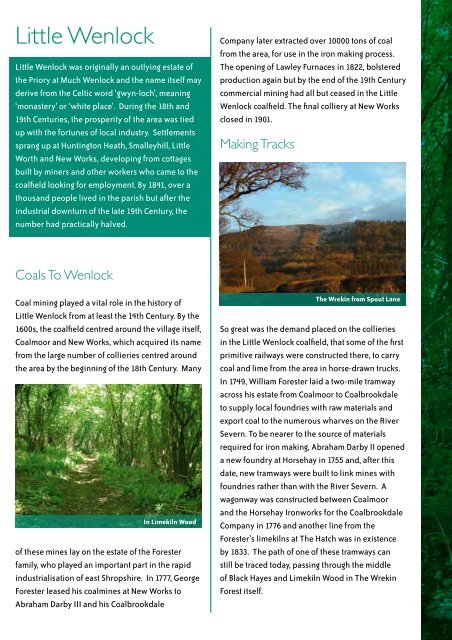All Round The Wrekin - Wellington Local Agenda 21 Group
All Round The Wrekin - Wellington Local Agenda 21 Group
All Round The Wrekin - Wellington Local Agenda 21 Group
You also want an ePaper? Increase the reach of your titles
YUMPU automatically turns print PDFs into web optimized ePapers that Google loves.
Little Wenlock<br />
Little Wenlock was originally an outlying estate of<br />
the Priory at Much Wenlock and the name itself may<br />
derive from the Celtic word ‘gwyn-loch’, meaning<br />
‘monastery’ or ‘white place’. During the 18th and<br />
19th Centuries, the prosperity of the area was tied<br />
up with the fortunes of local industry. Settlements<br />
sprang up at Huntington Heath, Smalleyhill, Little<br />
Worth and New Works, developing from cottages<br />
built by miners and other workers who came to the<br />
coalfield looking for employment. By 1841, over a<br />
thousand people lived in the parish but after the<br />
industrial downturn of the late 19th Century, the<br />
number had practically halved.<br />
Coals To Wenlock<br />
Coal mining played a vital role in the history of<br />
Little Wenlock from at least the 14th Century. By the<br />
1600s, the coalfield centred around the village itself,<br />
Coalmoor and New Works, which acquired its name<br />
from the large number of collieries centred around<br />
the area by the beginning of the 18th Century. Many<br />
In Limekiln Wood<br />
of these mines lay on the estate of the Forester<br />
family, who played an important part in the rapid<br />
industrialisation of east Shropshire. In 1777, George<br />
Forester leased his coalmines at New Works to<br />
Abraham Darby III and his Coalbrookdale<br />
Company later extracted over 10000 tons of coal<br />
from the area, for use in the iron making process.<br />
<strong>The</strong> opening of Lawley Furnaces in 1822, bolstered<br />
production again but by the end of the 19th Century<br />
commercial mining had all but ceased in the Little<br />
Wenlock coalfield. <strong>The</strong> final colliery at New Works<br />
closed in 1901.<br />
Making Tracks<br />
<strong>The</strong> <strong>Wrekin</strong> from Spout Lane<br />
So great was the demand placed on the collieries<br />
in the Little Wenlock coalfield, that some of the first<br />
primitive railways were constructed there, to carry<br />
coal and lime from the area in horse-drawn trucks.<br />
In 1749, William Forester laid a two-mile tramway<br />
across his estate from Coalmoor to Coalbrookdale<br />
to supply local foundries with raw materials and<br />
export coal to the numerous wharves on the River<br />
Severn. To be nearer to the source of materials<br />
required for iron making, Abraham Darby II opened<br />
a new foundry at Horsehay in 1755 and, after this<br />
date, new tramways were built to link mines with<br />
foundries rather than with the River Severn. A<br />
wagonway was constructed between Coalmoor<br />
and the Horsehay Ironworks for the Coalbrookdale<br />
Company in 1776 and another line from the<br />
Forester’s limekilns at <strong>The</strong> Hatch was in existence<br />
by 1833. <strong>The</strong> path of one of these tramways can<br />
still be traced today, passing through the middle<br />
of Black Hayes and Limekiln Wood in <strong>The</strong> <strong>Wrekin</strong><br />
Forest itself.


